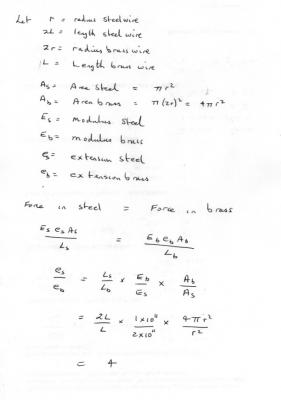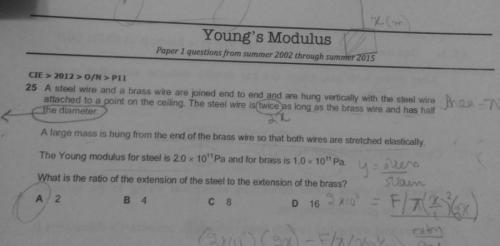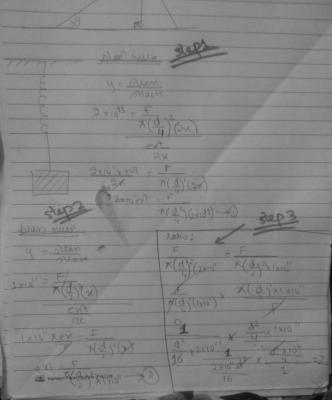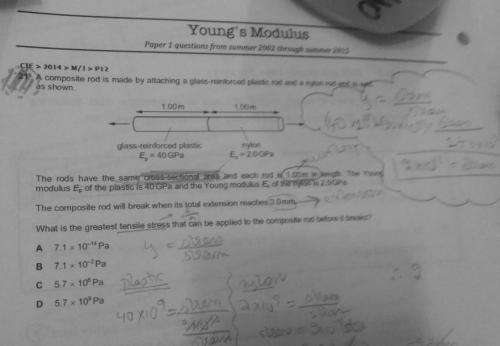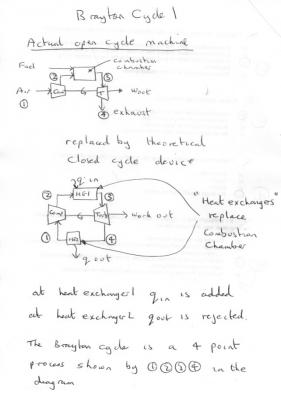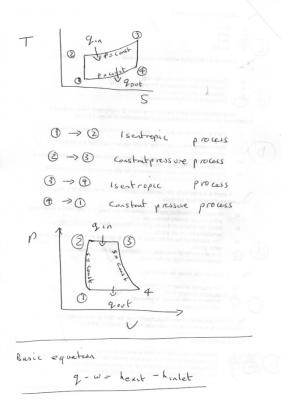-
Posts
17639 -
Joined
-
Last visited
-
Days Won
93
Content Type
Profiles
Forums
Events
Everything posted by studiot
-
Yes and NO. Yes you have calculated the total power dissipated in both cases by the 6 volt EMF. But in the first case half this power is dissipated in the internal resistor R and half in the external resistor R. So you lost a factor of 2 in your answer, since you are asked to compare the power in the external resistor only in both cases. Remember always read the question twice.
-
The energy doesn't disappear. (But that was a reasonable question) Current is rate of change or movement of charge. So if the current is zero then there is no movement of charge. If there is no movement of charge ie no current there is no change in energy. Voltage (by itself) is not energy. A battery that is not connected does not loose energy (except for leakage and old age) But once you connect a circuit, charge flows as a current and the battery looses energy to the circuit. Two equal voltages in opposition yield a net zero voltage in the same way that two equal forces in opposition in mechanics yield a net zero force. If the net force is zero, nothing moves and no work is done. The statement no work is done means there is no change of (mechanical) energy.
-
So what is the 'old' power and what is the 'new' power ? You know the voltage and the resistance so what formula do you think is appropriate here?
-
Look at the following correspondences. When all the rates of change are uniform. velocity is rate of change of distance : current is rate of change of charge So distance ( symbol s) corresponds to charge (symbol q) acceleration is rate of change of velocity : I will call rate of change of current p The kinematics equation s = ut + 0.5 (f t2) Where s is distance, u is initial velocity, t is time and f i acceleration. This equation also applies to your uniform change of current. i = initial current = 100mA the current changes from 100mA to 20 mA in 8 seconds ie (20 - 100) /8 = -10 mA per second. So p = 10 mA/s2 Changing our formula from s = ut + 0.5 (f t2) to q = it + 0.5 (pt2) = 8 q = 100 * 8 + (-10 *64) millicoulombs which I think you will find is answer A Edit q = 100 * 8 + 0.5(-10 *64) millicoulombs which I think you will find is answer C
-
Oh dear, you haven't got electrics yet. You need to practise lots of examples until it clicks in your mind. ~The Maximumpower theorem states The maximum power is delivered to a load when the load resistance is equal to the internal resistance. So the curve has a maximum at this point. There is only one graph that fits this description.
-
Since I'm sure you haven't covered differential equations here is another way. Have you done motion under constant acceleration yet?
-
In the old circuit there are two resistors. Are they in series or parallel and what is their combined resistance?
-
The Mac has always also had for video editing a full blown movie maker that works as part of the operating system.
-
You will probably find better support here. http://www.scienceforums.net/forum/28-suggestions-comments-and-support/
-
First an apology. These, of course, should have be x and y are the extensions, not the strain. However the math was correct and this oversight obviously didn't bother you. well done. Now for your second question. I'm sorry I have no experience with cellphone cameras so can't help with the rotation/posting. Try asking one of the younger members. I would say, however, that if you can, greyscale saves memory and transmission bytes, when colour is not needed. Here are your rotated and greyed images plus my working of the problem. Note I have used the radii not the diameters, since this avoids some extra fractions. I suspect you have got some (one) of the fractions the wrong way up, so the fewer the better. Once again the problem solution depends upon the force being the same in both.
-
You should have something like this Let x = strain in grp section Let y = strain in nylon section Then (x + y)* 10-3 = 3 * 10-3, where x and y are in mm Stress in grp = stress in nylon Egrp * x * 10-3 = Enylon * y* 10-3 Egrp * x = Enylon * (3-x) I'm sure you can finish the arithmetic.
-
In the case of the composite rod, pulled in tension at both ends, yes this is correct. So can you now calculate the strain for both pieces and complete the question, including the max stress?
-
I have only been talking about the question from your other post, which I see now is different from the original question in this thread. I can only deal with one subject at a time.
-
Now we are getting somewhere. if the youngs moduli (note the plural) are different, how can the stress and strain both be the same? Do you think the stress or the strain or both are different?
-
And what is your definition of young's modulus?
-
Is that all? What about the tensile force The stress The strain ?
-
Sorry but your originals are such a mess I don't know what I got right or wrong, but you posted the following yesterday If you can't get the page all in the other way round copy it out yourself so it fits your phone. Now how about answering the question I asked, which is relevent to the question you posted in the other thread, and I reposted properly here.
-
Question for you : what is the same and what is different in each of the sections of the composite rod? Why did you not add this to your previous thread question? Please ask a mod to combine the two threads. Edit for those who would like to see the original question
-

Thermodynamics Assignment (3RD YEAR engineering Thermodynamics)
studiot replied to Dreamsword's topic in Homework Help
I'm not sure you have fully appreciated my initial offering. The theory of heat engines depends upon working in a cycle. This means that we end up where we started with a mass of working fluid'. That is the working fluid is returned to its initial state. If heat or work is added somewhere in the cycle then it must be removed somewhere else in the cycle. The Brayton cycle is paticularly important to understand as it forms the basis of lots of different types of heat engine. The work integral around the cycle of such a machine is equal to the difference between the heat received at one temperature minus the heat rejected at another. [math]\oint {W = {\rm{Heatreceived}}\;{\rm{ - }}\;{\rm{Heatrejected}}} [/math] Four stages are identified and it is good to work per unit mass of circulating fluid. 1 - 2 : Adiabatic isentropic compression according to the law [math]P{V^\gamma } = C[/math] Pressure increase from P1 to P2 Temperature increase from T1 to T2 Volume decreases from V1 to V2 Entropy remains constant S1 = S2 2 - 3 Constant pressure heat addition This can be caluclated from the heat (enthalpy) of combustion, assuming complete combustion or by applying Cp(T3 - T2) Pressure remains constant at P2 = P3 Temperature increases from T2 to T3 Volume increases from V2 to V3 Entropy increases from S2 to S3 3 - 4 Adiabatic isentropic expansion according to the law [math]P{V^\gamma } = C[/math] Pressure decrease from P3 to P4 Temperature decrease from T3 to T4 Volume increases from V3 to V4 Entropy remains constant S3= S4 4 - 1 Constant pressure heat rejectionThis can be calculated from by applying Cp(T4 - T1) Pressure remains constant at P4 = P1 Temperature decreases from T4 to T1 Volume decreases from V4 to V1 Entropy decreases from S4 to S1 You have been given some of the pressures, temperatures etc and can use these stages to calculate the missing ones and thus answer the questions. Beware that some temperatures are stated in absolute and some in centigrade in your diagram. To test for condensation you then have the PVT within and through the turbine to compare against a state diagram for water. -
These things rarely arrive on their own Often good programs like ADW cleaner won't install or run properly. Further no single program kills them all. I have found this French one (Junkware Removal Tool) runs in most circumstances, when others will not. http://www.bleepingcomputer.com/download/junkware-removal-tool/ If JRT followed by ADW Cleaner does not do the trick then the bleeping computer site provides real help in cleanup. When the bad guys are gone run the following Microsoft tools, in this order. Disk Cleanup CheckDisk System File Checker. MSconfig Finally Super Anti Spyware runs well alongside most anti virus so load it when you have finished cleanup, http://www.superantispyware.com/ There is a free version.
-

Thermodynamics Assignment (3RD YEAR engineering Thermodynamics)
studiot replied to Dreamsword's topic in Homework Help
You are looking along the right lines, but rather than develop you own version Brayton analysis you should get a solid grasp of the conventional one. The Brayton cycle is also called the constant pressure cycle or the Joule cycle. The first thing to notice is that the machine arrangement as diagrammed is an open system and you need a closed cycle to create an analysis. The idea is to chose a working fluid (air or air/fuel as an ideal gas) and develop a cyclic process involving it. We do this by choosing to consider cycling our working fluid round four stages. (so there is no air input or output) Instead of combustion, heat is considered added from an external source at constant pressure (Cp times the temperature change) in the second stage of the cycle and a different quantity of heat is rejected to atmosphere in the final stage. This approach leads to some very simple equations. All the combined fuel and air is considered as a single ideal gas. I have outlined this in the attached diagrams. We can discuss these further if you like. -

Thermodynamics Assignment (3RD YEAR engineering Thermodynamics)
studiot replied to Dreamsword's topic in Homework Help
Your picture is too small to read. When you repost it, please also say specifically what your question is, this is too general. -

Formalization - does this make sense?
studiot replied to AllCombinations's topic in Linear Algebra and Group Theory
Great help there, wtf. +1 -
Please explain what this means?
-

Cymatic geometry and logic in sound.
studiot replied to 0exegesis's topic in Modern and Theoretical Physics
Much work connecting (acoustic) science to music was carried out by the late victorians (Lord Rayleigh: The Theory of Sound is still the definitive classic text) and in the early part of the 20th century. The 20th century saw the study widened to include the mechanics of the human audio system, both physiological and psychological. Philips (Eindhoven) carried put much research in the 1940s to the 1960s and produced a marvellous book on the subject. Unfortunately I have lost my copy. There is much reported in the Blackie Student's Physics series, vol II, Acoustics by Wood. In modern times there have been a number of good texts, websites (some teaching) and so on devoted to this. You can even take degree courses in the subject at Cardiff and London Universities. https://www.google.co.uk/search?hl=en-GB&source=hp&biw=&bih=&q=the+physics+of+music&gbv=2&oq=the+physics+of+music&gs_l=heirloom-hp.3..0l10.815.4290.0.4747.20.13.0.7.7.0.192.1518.3j10.13.0....0...1ac.1.34.heirloom-hp..0.20.1796.4U6t-WdYkY8 Go well in your search.


